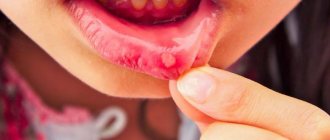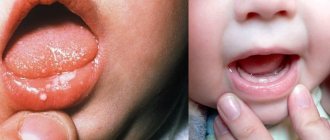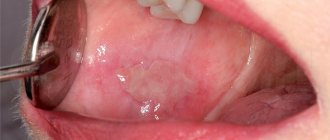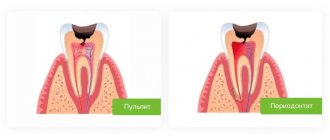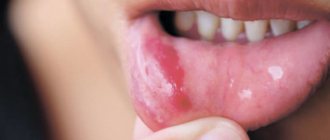Bubbles with yellowish contents on the mucous membrane of the cheeks, back of the tongue, and lips cause pain to the baby and are accompanied by drooling and low-grade fever. Active children become lethargic, sleep restlessly, and are capricious. This is how herpetic stomatitis manifests itself - damage to the mucous membrane provoked by the type I herpes virus. The disease is not dangerous if treated correctly. In the absence of medical supervision or self-medication, the symptoms disappear, but a chronic form may develop, laryngitis, and conjunctivitis may develop.
Herpetic stomatitis in children: general information
Children from six months of age to 5 years are most vulnerable to infection. By 6 months, the protective antibodies received from the mother are gradually eliminated, and one’s own immunity is still weak. The virus is transmitted from parents through licked nipples and spoons, and kisses.
Herpetic stomatitis in a 2-year-old child appears during the first active contacts with children. Infection occurs through toys and dirty hands. At 3–6 years old, the child goes to kindergarten, attends clubs and sections. Adaptation to a team, stress, psycho-emotional tension weaken the immune system. Therefore, acute herpetic stomatitis (AHS) in pediatric dentistry is the leader among inflammations of the oral cavity.
In addition to weak immunity, the development of stomatitis is facilitated by:
- Failure to comply with hygiene rules.
- Hypothermia and overheating.
- Damage to the mucous membrane.
- Past ENT diseases, ARVI.
- Poor diet and vitamin deficiency.
Stomatitis. What do they eat them with?
Authors : Solovyov D.V.
What is good about medicine (for a doctor ) is that it uses a specific language that is not very familiar to most patients. As a result, the doctor can talk about basically nothing, but in such a way that you will be confident in his intelligence and irresistibility. For example, when I hear that a doctor has diagnosed stomatitis, I already want to kill this pediatrician/therapist. Let me explain. First, let’s imagine a situation: a person has some kind of swelling in his mouth, he goes to the doctor, who confidently says: “Yes, you have stomatitis, father.” What are you saying, doctor, it can’t be! “Yeah, yeah, he is it, darling.
) is that it uses a specific language that is not very familiar to most patients. As a result, the doctor can talk about basically nothing, but in such a way that you will be confident in his intelligence and irresistibility. For example, when I hear that a doctor has diagnosed stomatitis, I already want to kill this pediatrician/therapist. Let me explain. First, let’s imagine a situation: a person has some kind of swelling in his mouth, he goes to the doctor, who confidently says: “Yes, you have stomatitis, father.” What are you saying, doctor, it can’t be! “Yeah, yeah, he is it, darling.
Common situation? Apparently the doctor did not make a mistake, he was able to recognize the trouble, and at the same time added to his authority. Now let's make a small insert. The fact is that the term “stomatitis” itself simply means “inflammation in the mouth.” And let’s now replace one thing with another in that very dialogue: - Yes, you have inflammation in your mouth, father. - ...
Now the conversation sounds bad, because the patient’s next phrase will most likely be completely different: “My dear, I can see for myself that there’s inflammation, what did you tell me that’s new?”
Do you feel the difference? Would you like it if, when you have a stomach ache, a doctor in a hospital happily said, “You have a stomach ache!”? We know this without you, that pain, you don’t need a doctor for that. Therefore, now remember one of the basic knowledge about stomatitis: there is no single diagnosis of “stomatitis”, there are a lot of different stomatitis. Therefore, when the doctor says that “there is stomatitis here,” this means that he is saying practically nothing, i.e. What kind of stomatitis this is, he still hasn’t figured out. True, in fairness, it must be said that many of the stomatitis are treated in the same way, but still not all, besides, knowing which one has decided to visit you is necessary not only for treatment. For example, this is necessary because some of them can be prevented or at least greatly alleviated at the very beginning.
So, the main points you need to know. The most common stomatitis is the so-called HRAS (chronic recurrent aphthous stomatitis), herpetic stomatitis and seizures.
Chronic recurrent aphthous stomatitis. This stomatitis is called recurrent (i.e. recurring) because it repeats during life approximately once or twice a year (more often in children), and aphthous - because it has very characteristic ulcers - aphthae, which look something like this:
This disease occurs in approximately 20% of people (i.e., it is quite common), and has been known since ancient times. Aphthae are most often single, appearing on the lips, cheeks, in the front of the mouth, on the palatine arches, tongue, and soft palate. The lesion is surrounded by a clear stripe of redness, it is quite painful, and in children it may be accompanied by general symptoms - malaise and poor health. Most often it goes away without a trace within two weeks, and the exact cause, unfortunately, has not yet been established.
Herpetic stomatitis. Caused by the herpes virus. It begins quite abruptly, with malaise, headache and pain in the mouth, which is especially difficult for children. A characteristic sign is small bubbles filled with liquid, something like this:
I would like to draw special attention to the fact that sometimes the diagnosis “herpangina” has nothing to do with herpetic stomatitis! It's just a similar (and not very good) name.
Jams. Almost everyone knows what it is, so here, perhaps, you can do without pictures. The most common causes of its appearance are streptococcus, cadidosis or iron deficiency anemia . Or rather, in children it is anemia that needs to be put in first place. Therefore, if you see that your child is visiting, don’t be lazy and take a blood test for iron. At the same time, I would like to draw special attention to the fact that it is impossible to eliminate anemia only by taking foods containing iron! There is no need to believe the recommendations that you just need to start eating pomegranates or meat in larger quantities and the anemia will disappear. It won't disappear. Products can maintain normal iron levels only when they were normal before. Anemia has appeared - it is necessary to take iron in the form of medications. There are also other stomatitis, but they are much less common.
Basic principles of treatment. I present only those things that are common to all types of stomatitis and that everyone can and should do, and at home. Some stomatitis also has its own specific treatment, which your doctor will prescribe for you.
- Pain is the leading sign of almost any stomatitis, so immediately eliminate any irritating (spicy, sour, salty) food from your diet.
- Your main task is pain relief. The easiest way to relieve pain is to pour a solution of 2% lidocaine from an ampoule into a spoon and either rinse with it for a couple of minutes (if this is an adult or child who can rinse without swallowing), or lubricate the sore spot with a cotton swab. There are also ready-made ointments with pain relief (for example, Kamistad for adults or Kalgel for children).
- Alternatively, you can freeze an ice cube in the refrigerator and suck on it (do not give to small children!).
- I was surprised to learn that it turns out that there are chewable tablets approved by the Ministry of Health that are recommended for children with teething and stomatitis. So remember: no chewable tablets should be given to infants! The reason is that small objects (including pills) easily end up in the respiratory tract of such children.
- If it is herpes, from the very first hours start taking an antiherpes drug: (for example: Zovirax (acyclovir), famciclovir (Famvir), valacyclovir (Valtrex), etc.). Remember that the sooner treatment is started, the easier you will get off.
- If iron deficiency anemia is detected, then salvation is taking iron. However, in this case, do not expect quick results. Everything here is aimed not so much at treating existing stomatitis, but at preventing its occurrence in the future.
- In addition to painkillers, you can use drugs that speed up healing. For example, this is aekol, vitamin A (naturally, in the absence of allergies).
- It may also be easier with simple rinsing. How? Even with ordinary water. The point is to wash away food residues from the painful mucous membrane, because what exactly you will do is the tenth thing.
Some additional information.
- Many stomatitis still have an unknown cause, so it is often simply impossible to establish it for sure.
- Naturally, when there is pain, it is quite difficult to brush your teeth (especially for a child). Overcome yourself, because uncleaning can lead to the addition of bacterial inflammation of the gums, which can be very difficult to cope with.
- If you see putrefactive processes on the edge of the gums in yourself or your child (this is a grayish or greenish coating), there is a further increase in temperature or a general deterioration in the condition, immediately consult a doctor!
- If stomatitis is of a traumatic nature (i.e., it appeared from constant trauma with a prosthesis or a sharp edge of a tooth), immediately get rid of the traumatic cause, because such stomatitis more often than others degenerates into cancer.
- Quite often, stomatitis is accompanied by diseases such as influenza, scarlet fever, measles, etc. Therefore, you should not leave such things to chance, even if you feel normal. If you see something unusual, especially in a child, it is better to ask a doctor.
- If you know that you are prone to developing a “fever” (herpes), you do not need to wait until the process is in full swing. As a rule, you already know exactly a certain sensation before the bubbles appear (usually it’s something like itching), so if you feel it, immediately apply the medicine. The faster you do this, the better the effect will be (it’s not the days that are important, but the hours). Remember that 95% of the world's population are carriers of the herpes virus; science cannot yet get rid of the virus once it has entered the body.
- The appearance of stomatitis of an allergic nature at least once is a reason to forever (or at least before the course of so-called desensitization) abandon the allergen that caused such stomatitis. Don't joke with allergies, these are deadly jokes.
- If any stomatitis lasts more than two weeks, this is a clear reason to visit the doctor again.
How to prevent stomatitis? Since stomatitis is different and has a completely different nature, there cannot be uniform recommendations. Sometimes stomatitis is contagious, sometimes it is not, so just in case, until the doctor expresses his opinion, you do not need to kiss the patient, or use shared utensils and towels. And also, in any case, do not forget about hygiene and, in particular, hand washing.
What not to do and what not to use.
- There is no need to use lidocaine 10% in aerosol. It anesthetizes well, but is not suitable for repeated use, because there remains a very unpleasant sensation of burning and tightening of the mucous membrane. (Also, do not forget that small children should not be sprayed with aerosols in their mouths in principle!)
- Never apply cauterizing drugs to your mouth! Firstly, with stomatitis it is wildly painful (for some reason parents especially like to do this, not for themselves, but for the child), and secondly, it can lead to the degeneration of the ulcer into all sorts of bad things.
- There is no need to use dyes (such as blue). They do not speed up healing in any way, but they do an excellent job of hiding everything, as a result of which the doctor may miss important points.
- Maraslavin at home: is still a very popular drug, although for some reason patients most often forget to inform that, firstly, it causes an increase in temperature (which is very undesirable, especially in children), and secondly, it causes loosening of the gums, making it impossible to brush your teeth at home (a visit to the doctor is required).
I will also draw attention to such a popular medicine as Cholisal. It has a very specific taste and especially smell. Therefore, before using it in children, try it in a very small dose. If the child takes it normally, use it; if not, it’s better not to force it.
Geographic tongue (desquamative glossitis). Let's take a special look at this state. It appears as whitish or “bald” spots, constantly changing their shape, size and position. One often gets the impression that the language seems to have a constantly changing picture, a “geographical map”:
Apart from appearance, there are usually no complaints; sometimes a slight tingling sensation may appear. This condition is a normal variant and does not require any treatment at all!
I hope that now you have received at least the most general knowledge of what stomatitis is and what you should eat it with. 
And the choice, as always, is yours. 
Consultations by Dmitry Solovyov at ClubCom
published 25/11/2013 13:32 updated 15/02/2018 — Diseases of the teeth and oral cavity, Dentistry
Symptoms of herpetic stomatitis
The severity of acute syndrome is determined by the combination of the severity of mucosal lesions and general symptoms (fever, headache, vomiting). With herpetic stomatitis, there is no transition from stage to stage - either immediately mild, severe, or moderate. In children, general symptoms prevail over local ones; even with minor inflammation of the mucous membrane, low-grade fever and weakness are observed.
Mild form of OGS. The rash is preceded by a rise in temperature to 37.5°C. After 1–2 days, catarrhal gingivitis develops (swelling, darkening, bleeding in the gingival margin). Salivation increases, and the submandibular lymph nodes may enlarge. Against the background of inflammation of the gums, bubbles (up to 3-5 pieces) appear in the mouth, which quickly open and turn into small ulcers with a white coating and reddened edges. Herpetic stomatitis on the tongue causes pain when talking, chewing, children refuse to eat. The rash appears once. After 1–2 days, the temperature returns to normal, swelling of the gums, pain and burning in the mouth decrease. Erosion heals without scars within 5–7 days.
Moderate degree of AHS. The onset of the disease is indicated by a slight increase in temperature, physical malaise, soreness and hardening of the submandibular and cervical lymph nodes. After a day or two, the part of the gum surrounding the teeth swells, turns red and aches, and the temperature rises to 38℃. On the reddened mucous membrane of the mouth and the skin of the perioral area, blisters appear in the amount of 5–15 pieces; they can unite into large painful ulcers with pink outlines and reappear. How long it takes for a child to get herpetic stomatitis depends on immunity, timeliness and effectiveness of treatment. Typically, the peak period of the disease lasts 7–10 days. Without adequate treatment, a herpetic infection can spread to the conjunctiva of the eyes, and ulcerative gingivitis with bleeding erosions, damage to the oropharynx, and deformation of the gingival papillae can develop.
Severe form of OHS. It develops rarely, in most cases in children with immunodeficiency. Already at the beginning of the disease, the lymph nodes in the neck and under the jaw become inflamed, and the temperature rises to 40℃. The swollen mucous membrane bleeds; after a day, bubbles form in the oral cavity, near the lips. New rashes appear repeatedly, you can see a vesicular rash at different stages of healing, merging erosions. Recovery is long (14 days or more), herpetic stomatitis can become recurrent and periodically worsen.
If you notice a rash in your child’s mouth or lips, sign up for a consultation. Our pediatric dentists and periodontist will find a common language with the little patient and quickly alleviate the condition.
Is stomatitis transmitted?
Allergic stomatitis
– one of the most common and intractable types of the disease.
The cause is an allergy, but what exactly is allergy is to be determined first. Allergens can be both food and medicine, as well as materials for dentures installed in the oral cavity. The typical course of stomatitis - the occurrence of painful ulcers - can be further complicated by difficulty breathing and swallowing, typical of allergies. Allergic stomatitis is not transmitted
except through hereditary means.
Viral (herpetic) stomatitis
- another popular type of this disease, especially common in small, close groups of people (schools, kindergartens, work groups, camps).
Its cause is the herpes virus, and its features are erosive spread (others may appear next to one ulcer) and the possibility of severe complications with fever, nausea, vomiting and diarrhea. This is the most contagious variety; in 80% of cases, this stomatitis is transmitted both by airborne droplets and by contact
.
Aphthous stomatitis
– most often occurs in adults, and is associated with weakened immunity.
That is why outbreaks of aphthous stomatitis occur mainly in spring and autumn. It is characterized by the formation of aphthae - small ulcers, both single and occurring in clusters. This stomatitis is not contagious
and cannot be passed on to other people.
Fungal stomatitis (candidomycosis)
– is characteristic of both children (mainly infants) and adults, and mainly women.
It occurs due to Candida fungi, which multiply in the mouth due to weakened immunity or long-term use of antibiotics. It is characterized, in addition to the formation of ulcers, by a white “curdled” coating on the tongue, palate and inner surface of the cheeks. This stomatitis is contagious
: it can be transmitted through direct contact or through household and hygiene items (towel, toothbrush, dishes). A pathogenic fungus can remain in the body for some time and develop in an environment favorable to it.
Nicotine stomatitis
– as the name suggests, occurs in smokers as a result of a long-term addiction to cigarettes.
Tobacco smoke, affecting the oral cavity, actively promotes the growth of bacteria, and also irritates the palate, the tissues become denser, resulting in the formation of numerous ulcers. This type of disease is especially dangerous: although it is not transmitted to other people
, and generally goes unnoticed for a long time, it can develop into oral cancer.
Treatment of herpetic stomatitis at the “Family Dentist”
Therapy for OHS is complex; in mild to moderate cases, it is carried out at home. The dentist prescribes medications, gives recommendations on nutrition and oral hygiene. The cost of an appointment in our clinic is from 10 rubles.
When herpetic stomatitis is diagnosed in children, the treatment regimen includes:
- Diet. Food should be liquid or semi-liquid (mashed soups, vegetable purees, cereals, jelly, yoghurts, minced meat and fish) at a comfortable temperature. In case of extensive erosions, it is advisable to feed the baby liquid food through a tube.
- Prevention of dehydration. Water balance is maintained with dried fruit compotes, broths, plain water, and a weak rosehip decoction.
- Oral hygiene. To prevent the development of a secondary infection, teeth should be cleaned with a soft brush without paste, and the mucous membrane should be treated with a swab and a warm antiseptic solution. You should rinse your mouth every time after eating.
- Local, general therapy. The drugs are prescribed by the dentist, taking into account the severity of the acute syndrome.
Mild degree. Ulcerations of the mucous membrane are treated 3-4 times a day with a cotton pad or bandage soaked in a solution of chlorhexidine 0.05% or miramistin. If necessary, the doctor prescribes an antiviral ointment. If there is no risk of seizures, antipyretic drugs are not prescribed.
Moderate degree. At the height of herpetic stomatitis, treatment with local antiseptic solutions is supplemented with tableted antiherpetic drugs, if the rash does not begin to dry out on the 2nd–3rd day. Medicines have an effect on the entire body, therefore they are taken only as prescribed by a doctor. The mucous membrane after a viral infection is restored with healing agents with vitamins A, E, and sea buckthorn oil. To reduce pain, lidocaine gel is applied to the mucous membrane 20 minutes before meals.
Severe degree. The dentist refers you to the hospital, treatment is carried out with injectable drugs, immunostimulants, and physiotherapy is prescribed.
To make an appointment at the “Family Dentist” in Minsk, fill out the form or call. You don't have to stand in line with a sick child.
Causes
Reasons for the development of the disease:
- weak immunity to viruses;
- thin mucous membrane with closely located blood vessels;
- insufficient oral hygiene measures.
Family Dentistry specialists note that the disease can be caused by buying an unsuitable toothbrush or new toothpaste, without the advice of a dentist, as well as staying in conditions of temperature changes.
How is childhood stomatitis treated?
After determining the nature of the disease, the doctor prescribes treatment. It goes in three directions:
Drug therapy. Medicines are prescribed taking into account the existing symptoms and type of stomatitis. The prescribed drugs are aimed at eliminating the causative agent of the disease and combating symptomatic manifestations - swelling, the appearance of mouth ulcers, pain and others.
Diet. The child is not given food that irritates the oral mucosa. Spicy, sweet, salty, sour - foods with these taste qualities are not recommended. A patient with stomatitis needs liquid or semi-liquid food that does not injure the mucous membrane.
Taking vitamins. Weakened immunity slows down the body's recovery during treatment. Strengthening with vitamin complexes promotes recovery and reduces the risk of recurrence of stomatitis.
Aphthous stomatitis: symptoms
Symptoms will largely depend on the form of the disease:
- Acute aphthous stomatitis is accompanied by a sharp increase in temperature to 38-39 degrees, decreased appetite, increased salivation, and the appearance of bad breath. The main and most characteristic symptom is the formation of redness and grayish ulcers (ulcers) on the oral mucosa with a pronounced inflamed rim. Ulcers are painful, and the pain intensifies when eating food (especially salty, spicy or sweet).
- Chronic aphthous stomatitis in children occurs in a milder form with periodic relapses (recurrent), during periods of exacerbation the symptoms are the same as in the acute form of the disease. At the stage of remission, the ulcers heal quite quickly, in severe cases they scar, and the scars then have to be additionally treated with absorbable agents.
Is aphthous stomatitis contagious? It is believed that in any form it is not contagious, but it is possible for adults to infect a child - by licking baby spoons or nipples, for example, or by not thoroughly washing children's toys, which the child then puts into his mouth.
